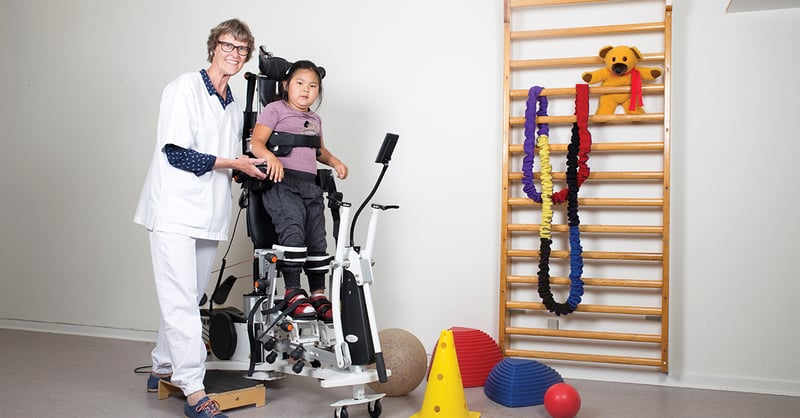Robotic gait rehabilitation delivers quicker results for kids with CP


A new prospective, controlled study found that robotic gait rehabilitation training (Innowalk Pro) provides faster and higher effects on the development of functional muscle strength, balance, walking speed and endurance compared to a standard physiotherapy rehabilitation program.
The study included 24 children with spastic hemiparetic cerebral palsy (CP), GMFCS I and II and revealed that robotic training (RGT) provided faster and higher effect than standard physiotherapy (PTR) program alone.
RGT improved:
- Functional muscle strength
- Balance
- Walking speed
- Endurance
- Functional walking performance
It is evident that RGT can be used for aerobic exercise training in children with hemiparetic CP to improve walking speed, which has critical effects in enhancing functionality and participation in daily life. The study also showed that the RGT should be a continuous exercise to preserve all improvements.
The findings are published in the peer reviewed journal Gait & Posture (vol 70 (2019) 397-402). You find the complete article “Effects of robotic rehabilitation on walking and balance in paediatric patients with hemiparetic cerebral palsy” here.
However, this is a brief summary of the article:
Introduction
Cerebral palsy is a group of permanent disorders related to a non-progressive brain injury. The condition affects the development of movement and posture, causing activity limitations. The most prevalent type of spastic CP is hemiparetic CP characterized by motor and/or sensory damage of unilateral limbs. Gait pattern deviates from normal and walking speed and balance, as well as competence in advance functional skills, are poor.
The study aimed to investigate the effects of robotic gait training (RGT) on functional walking, balance, muscle strength and peripheral oxygenation of children with hemiparetic cerebral palsy.
Method
24 children with hemiparetic CP, GMFCS I-II (20 GMFCS I and 4 GMFCS II), aged 5-12 years, was enrolled in this prospective, controlled study. 12 patients participated in the robotic gait training (RGT) in addition to the standard physiotherapy rehabilitation (PTR) program. The control group (12 patients) attended the standard PTR program. The RGT was performed 3 x per week in sessions of 30 minutes each.
Standard physiotherapy rehabilitation (PTR) program included functional strengthening exercise for antigravity muscles of the lower extremities, stretching exercises for flexor muscles of the knee and hip, plantar flexors, and adductor muscles, terminal squat, stair climbing-descending exercises, functional reaching, balance training using a balance board, and standing on a single leg.
For the robotic gait training (RGT) the Innowalk Pro was used. The training in the Innowalk Pro was performed as an aerobic exercise, targeting HR interval between 55-75% of maximum HR.
Study evaluations were performed before the treatment, right after the treatment (at the end of the 12-week intervention), and 3 months post-treatment.
Results
The after-treatment evaluations found several interesting outcomes:
- A 6-min walk test demonstrated that the distance walked was three times as long in the study group as for the control group.
- The gross motor functions score had significantly improved for standing and walking in the study group, whereas changes were found only in standing performance for the control group.
- Functional muscle strength evaluations of the lower extremities (lateral step-up test, sit-to-stand test, half kneeling standing test) revealed significant improvements in the study group for all parameters except for standing from half kneeling on the paretic extremity
- Muscle oxygenation increased in 9 of the patients in the study group and in 5 of the patients in the control group.
The 3 months post-treatment evaluation showed that the remarkable improvement in speed and endurance (6MWT) for the study group was not preserved. The increase in muscle oxygenation remained in the majority of the group (totally 8 of 9 patients). The duration of standing on the paretic extremity increasingly continued, and improvements in balance was preserved. Motor function was maintained, same for functional muscle strength which was either increasingly continued or preserved.
Conclusion
The study revealed that robotic training (RGT) provided faster and higher effect than standard physiotherapy (PTR) program alone. RGT improved:
- Functional muscle strength
- Balance
- Walking speed
- Endurance
- Functional walking performance
It is evident that RGT can be used for aerobic exercise training in children with hemiparetic CP to improve walking speed, which has critical effects in enhancing functionality and participation in daily life. The study also showed that the RGT should be a continuous exercise to preserve all improvements.
Do you want to know more about CP?
Read our resource page with answers to most of your questions.

Rikke Damkjær Moen brings many years of experience as clinical physiotherapist to the Made for Movement team. Her mission is to ensure that everybody, regardless of mobility problems, should be able to experience the joy and health benefits of physical activity. As our Medical Manager, Rikke is passionate about sharing knowledge so that individuals with special needs, families, and clinicians can discover the possibilities and solutions provided by Made for Movement.
A severe accident during a hockey game resulted in 35-year-old Tobias breaking his neck and becoming paralysed from the armpits down....
A disability entails the loss of, damage to, or deviation from bodily or psychological functions, in the form of mental, physical,...
The Neurological Interdisciplinary Treatment Centre NiB (Neurologisches Interdisziplinäres Behandlungszentrum) is an innovative...
Hear from us from time to time and learn new things
